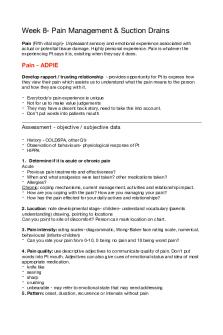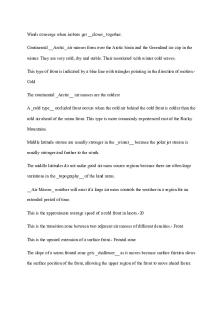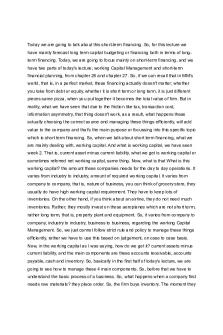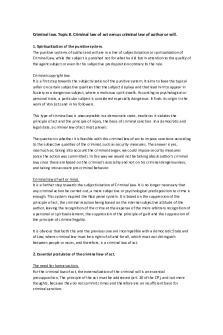Econ10003 lecture 8 PDF

| Title | Econ10003 lecture 8 |
|---|---|
| Course | Introductory Macroeconomics |
| Institution | University of Melbourne |
| Pages | 27 |
| File Size | 794.8 KB |
| File Type | |
| Total Downloads | 36 |
| Total Views | 114 |
Summary
lecturer: Chris Edmon...
Description
Introductory Macroeconomics Lecture 8: fiscal policy (in ordinary times) Chris Edmond & Daeha Cho 1st Semester 2020
1
Revised Schedule: Rest of Part I • Lecture 8 (March 30) fiscal policy in ordinary times • Lecture 9 (April 1) fiscal policy in extraordinary times • Extended Easter break April 6 – April 19 • Lecture 10 (April 20) monetary policy in ordinary times • Lecture 11 (April 22) monetary policy in extraordinary times • Lecture 12 (April 27) aggregate demand and supply, part one • Lecture 13 (April 29) aggregate demand and supply, part two
2
Revised Schedule: Part II
• Then Daeha Cho takes over lectures
• Lectures 14 – 23, on long-run macro and open economy macro
• Last lecture for this subject is now June 3
3
Revised Due Dates • Online multiple choice #1 April 2 to April 3 (this week)
• Online multiple choice #2 May 21 to May 22 (unchanged)
• Assignment #1 April 22 (pushed back after extended Easter break)
• Assignemnt #2 May 27 (pushed back)
4
Fiscal Policy (in Ordinary Times)
5
Rest of This Lecture • Fiscal policy in ordinary times
– basic fiscal policy concepts – more on fiscal policy and demand management – government budget constraint, debts and deficits
• BOFAH chapter 8
6
Basic Fiscal Policy Concepts • Government decisions to spend, raise revenue, and issue debt • Expenditure – government purchases of goods and services schools, police, courts, military, roads – transfers to households and firms age pension, newstart, parental support – interest payments to holders of government debt • Revenue – personal and company income taxes, GST, excises, land taxes • Levels of government (commonwealth, state, local) 7
Government Expenditure Australia Major categories, 2017/18, billions of dollars
Defence Education Health Social protection Transport Economic affairs .. . Total
Commonwealth 32.0 37.3 76.8 158.9 9.4 20.7
Total 32.0 99.6 129.6 178.1 32.7 30.1
463.9
647.1
8
Government Expenditure Across Countries
9
Government Revenue Australia Major categories, 2017/18, billions of dollars
Income, profits and capital gains Payroll Property GST etc .. . Total
10
Commonwealth 312.4 1.1 0.0 106.5
Total 312.4 24.7 30.3 141.5
427.2
528.6
Government Revenue Across Countries
11
Fiscal Policy and Demand Management
12
Fiscal Policy and Demand Management
• Keynes argued should use fiscal policy to stabilise business cycle
• Use G and T to offset temporary shortfalls in private spending
13
Fiscal Policy and Demand Management
14
Limits of Fiscal Policy in Demand Management • Possible side-effects – changes in taxes may distort incentives to work and invest – deficit-financed government spending may push up interest rates, ‘ crowding out ’ private sector investment • Practical concerns – lags in making and implementing decisions – lags between decision and time spending effects economy – tension between getting timing right and most worthwhile spending (e.g., infrastructure timing) – waste
15
Government Budget Constraint
16
Government Budget Constraint • Period-by-period government budget constraint
Gt + iBt + T ransf erst = T axes t + (Bt+1 − Bt ) | {z } | {z } uses of funds
sources of funds
where
Gt = government purchases of goods and services iBt = interest payments on existing government debt Bt+1 − Bt = change in government debt T ransf erst = transfer payments from government T axest = tax revenue • To simplify notation
Tt = T axest − T ransf erst = net taxes 17
Government Budget Constraint
• With Tt denoting net taxes (taxes minus transfers)
Gt + iBt = Tt + (Bt+1 − Bt )
• What is the relationship debt and the government deficit ?
18
Debts and Deficits • The amount of government debt is Bt • Government deficit is the change in government debt
Bt+1 − Bt = Gt − Tt + iBt • Hence
deficit positive
Bt+1 − Bt > 0
⇔ debt increasing
deficit negative
Bt+1 − Bt < 0
⇔ debt decreasing
• Deficit is sum of primary deficit Gt − Tt plus interest payments iBt
on existing government debt 19
Government Deficits Relative to GDP
20
Government Debt Relative to GDP
21
Gross Debt vs. Net Debt
• More precisely, this is gross government debt
• What if we look at the asset side of balance sheet?
• Assets minus liabilities gives a measure of government net wealth
22
Government Net Wealth Relative to GDP
23
Can Governments Keep Accumulating Debt? • Government period-by-period budget constraint
Bt+1 − Bt = Gt − Tt + iBt
• Government borrowing today implies interest cost tomorrow
• To get complete complete picture, need to rollover the
period-by-period budget constraint • Result is the government’s ‘ intertemporal budget constraint ’
24
Digression on Present Values • If interest rate is i > 0, present value of a dollar in t periods
✓
1 1+i
◆t
• Present value of a sequence {X} = {X0 , X1 , X2 , . . . } is
PV({X}) = X0 +
✓
1 1+i
◆1
◆t ∞ ✓ X 1 Xt = 1 + i t=0
25
X1 +
✓
1 1+i
◆2
X2 + · · ·
Intertemporal Budget Constraint • With some algebra (omitted), government’s intertemporal budget
constraint can be written in the form B0 =
1 PV({T − G}) 1+i
• Government debt outstanding cannot be more than present value
of future primary surpluses – debt is current promise to make future payments – current deficit must be offset by future surpluses
26
Next Lecture
• Fiscal policy in extraordinary times
– global financial crisis
– coronavirus pandemic
27...
Similar Free PDFs

Econ10003 lecture 8
- 27 Pages

8 - Lecture notes 8
- 21 Pages

8 - Lecture notes 8
- 21 Pages

Lecture 8 - 8 lec
- 6 Pages

Lecture 8
- 1 Pages

Lecture 8
- 5 Pages

Lecture 8
- 3 Pages

Lecture 8
- 2 Pages

8 Midwifery - Lecture notes 8
- 3 Pages

Taxation 8 - Lecture notes 8
- 2 Pages

Week 8 - Lecture notes 8
- 6 Pages

CH 8/ Lecture 8 ANSWERS
- 13 Pages

Dox 8 - Lecture notes 8
- 21 Pages

Lesson 8 - Lecture notes 8
- 2 Pages

Assignment 8 - Lecture notes 8
- 4 Pages

Week 8 - Lecture notes 8
- 23 Pages
Popular Institutions
- Tinajero National High School - Annex
- Politeknik Caltex Riau
- Yokohama City University
- SGT University
- University of Al-Qadisiyah
- Divine Word College of Vigan
- Techniek College Rotterdam
- Universidade de Santiago
- Universiti Teknologi MARA Cawangan Johor Kampus Pasir Gudang
- Poltekkes Kemenkes Yogyakarta
- Baguio City National High School
- Colegio san marcos
- preparatoria uno
- Centro de Bachillerato Tecnológico Industrial y de Servicios No. 107
- Dalian Maritime University
- Quang Trung Secondary School
- Colegio Tecnológico en Informática
- Corporación Regional de Educación Superior
- Grupo CEDVA
- Dar Al Uloom University
- Centro de Estudios Preuniversitarios de la Universidad Nacional de Ingeniería
- 上智大学
- Aakash International School, Nuna Majara
- San Felipe Neri Catholic School
- Kang Chiao International School - New Taipei City
- Misamis Occidental National High School
- Institución Educativa Escuela Normal Juan Ladrilleros
- Kolehiyo ng Pantukan
- Batanes State College
- Instituto Continental
- Sekolah Menengah Kejuruan Kesehatan Kaltara (Tarakan)
- Colegio de La Inmaculada Concepcion - Cebu